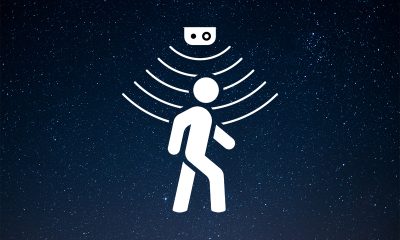General description
Bluetooth lighting controls refer to a family of embedded and self-contained products that serve to build wireless network connectivity and IP-based controllability into luminaires, lamps, sensors, switches and other control devices. They provide protocol stack processing and application layer functionalities required to run a Bluetooth network. Smart lighting relies on the use of a connectivity platform to enable data exchange, distribute control logic, and coordinate operations between the connected devices. The convergence of solid-state lighting (SSL) based on LED technology with the Internet of Things (IoT) is set to open up a new world of value creations. The IoT realm would be an illusion without a robust communication network as a foundation. Bluetooth arrived at the frontier of IoT transformation. It delivers out-of-the-box seamless connectivity and individual addressability to homogeneous and homogeneous classes of digital devices and enables their integration, interoperation and collaboration.
What is Bluetooth
Operating in the Industrial Scientific Medical (ISM) 2.4 GHz band from 2.4 to 2.4835 GHz and managed by the Bluetooth Special Interest Group (SIG), Bluetooth evolved over multiple iterations to stand out among other wireless personal area network (WPAN) standards. The original Bluetooth, known as Bluetooth Classic, is used as a short-range, cable-replacement technology for streaming data between personal computing equipment (desktop computers, laptops, smartphones, and tablets) and various peripherals (headsets, speakers, printers, webcams, wireless keyboards and mice). Beginning with version 4, Bluetooth Low Energy (BLE), more commonly known as Bluetooth Smart, became part of the Bluetooth standard that is intended to address the need for low-power communication. Its popularity has grown exponentially since the release of the Core Specification version 4.2 in 2014. The Bluetooth 4.2 specification supports 6LoWPAN-based Internet Protocol (IP) connectivity and introduced greater improvements in communication range, packet capacity, privacy and security. Further enhancements were brought by Bluetooth 5 which quadrupled the range, doubled data throughput and provided an eightfold increase in packet capacity. The mesh profile and mesh model specifications released in 2017 finally transformed Bluetooth into a native IoT protocol.
Network specifications
Rather than streaming data continuously on 79 data channels (1 MHz channel bandwidth) that has been the case for Bluetooth Classic, BLE is a packet-based protocol that supports quick transfer of small packets of data using 40 2MHz-wide channels. The major advantage of this communication technology is its low power consumption relative to its decent bandwidth capabilities. The physical layer data rate of Bluetooth networks is 1 Mbps. The IEEE’s 802.15.4 standard, which defines the physical layer of the ZigBee, Thread and SNAP protocol stack, caps the data rate at 250 kbps. The physical channels are organized into 3 advertising channels for device discovery, connection establishment and broadcast transmission and 37 data channels for bidirectional communication. BLE supports proximity sensing by broadcasting a beacon (tiny short-range transmitter) at regular intervals, which opens the door to location-based services such as location-based push notifications and geo-fencing. All physical channels use a Gaussian Frequency Shift Keying (GFSK) modulation.
The ISM band of 2.4GHz is crowded with other protocols that have such ubiquitous technologies as ZigBee and Wi-Fi. All RF networks working in this band therefore must mitigate interference issues. BLE employs an adaptive frequency-hopping spread spectrum (FHSS) approach to overcome the frequency-static interference and uses a collaborative spectrum allocation scheme to combat the frequency-dynamic interference. At the link layer BLE defines two device roles: master and slave. A master can establish connections with multiple (between 10 and 20) slaves simultaneously over a communication range of up to a few tens of meters, whereas each slave can only use unicast to communicate with one master. Thus, the network architecture, which is called a piconet, follows a star topology.
Mesh networking
Bluetooth mesh transforms the single-hop BLE topology into a fully decentralized architecture that supports multi-hop, peer-to-peer communication. A mesh network implements a many-to-many topology. Each node communicates with every other node in its direct radio range. It broadcasts a message to every adjoining node which will then participate in broadcasting and relay the received message until the destination is reached. This method is known as flooding, which contrasts with other mesh networks that use destination-based routing (ZigBee, Thread) and source-based routing (Z-Wave).
Bluetooth mesh has a publish/subscribe messaging model which allows the nodes can publish messages using unicast, virtual, or group addresses. A node can subscribe to or publish messages to a specific group or virtual destination address. Managed flooding and publish/subscribe communication work together to create a robust mesh work that is highly reliable, efficient, and scalable. Every message is provided with multiple redundant paths to overcome communications interruptions that may occur due to interference, physical obstruction or multipath fading. Automatic recognition and association of new nodes makes the network simple to implement and operate. The multi-hopping capability allows the end-to-end communication range to be easily extended. A Bluetooth mesh network can scale to support a large network with up to 32,000 nodes over a greater physical area.
Managed flooding
The flooding approach used by Bluetooth mesh offers distinct advantages. It doesn’t involve the use of sophisticated routing tables and thus uses less memory and less processing power. Without the burden of conveying routing information, the overhead can be kept under very strict limits to minimize the size of data packets. This in turn maximizes the efficiency of wireless data transmission. With very compact data packets, the radio spectrum of the ISM band can be used to distribute a large number of messages to multiple nodes in a single transmission with minimal latency. This feature lends Bluetooth mesh a unique capability to handle the significant amount of multicast messaging traffic that often occurs in large-scale commercial and industrial lighting control applications. To stay efficient, Bluetooth mesh uses the managed flooding technique to send data. Every message has a unique sequence number and a time-to-live counter (TTL) which are used to optimize the network usage and to protect against replay attacks.
Routed networks don’t relay data packets by flooding the network through broadcasts. They must create and maintain routing tables to determine the next hop for each message to be routed. This requires the use of dedicated resources to run algorithms and store routing tables, which increases complexity as well as the cost of each node. In large mesh networks, routing tables can grow correspondingly large to take up a considerable amount of memory in the routers. Constantly running algorithms to update routes and make real-time packet forwarding decisions will consume substantial computational resources.
A full stack solution
Bluetooth mesh is a full stack solution that affords the maximum level of compatibility and interoperability with the IoT ecosystem. The mesh architecture stack is built upon the full BLE stack and further includes the bearer layer, network layer, lower transport layer, upper transport layer, access layer, foundation model layer, and model layer. The BLE stack provides fundamental wireless communications capabilities. The bearer layer defines how a packet data unit (PDU) will be handled. Mesh PDUs may be transported by an advertising bearer or a GATT (Generic Attribute Profile) bearer. An advertising bearer leverages the Generic Access Profile (GAP) layer of the core BLE stack to send and receive data packets. A GATT bearer allows a mesh node to communicate with non-mesh BLE devices. The network layer defines the format and address type of PDUs to be transported by the mesh bearers. The lower transport layer delivers PDUs to the lower transport layer on a peer node and performs segmentation and reassembly of PDUs when needed. The upper transport layer encrypts, decrypts and authenticates application data passing to and from the access layer. The access layer defines the format of application data and orchestrates the encryption and decryption process performed in the upper transport layer. The foundation model layer manages models related to the configuration and management of a mesh network. The model layer defines the functionality of nodes on a network. A model represents a service in regular Bluetooth devices. Mesh models are divided into three categories: client models, server models, and control models.
Network nodes
There are different types of nodes in a Bluetooth mesh network. In addition to the ability of transmitting and receiving mesh messages, some of them support one or more additional features. These nodes are classified based on their features. Proxy nodes relay messages between the GATT interface and advertising bearers for BLE devices that do not possess a Bluetooth mesh stack, allowing them to interact with nodes in a mesh network. Relay nodes retransmit received packets over the advertising bearer to enable multiple “hops” in the network. A low power node is a battery-powered device that operates in low duty cycles and relies on the support of a friend node to establish an association with other nodes. The friend node stores cache of all incoming messages addressed to the LPN and deliver them whenever the LPN wakes up. A Bluetooth mesh node may have one or more elements which are independently controlled units. Every element is assigned with a unicast address.
Intelligent networking
A networked lighting control solution is designed to enable intelligent networking of lighting systems, sensors, and switches. They may also be required to have the capability to cooperate and communicate with other networks, systems and devices beyond their boundaries to implement more sophisticated control strategies and achieve a higher level of operational efficiency. The wireless network is based on an information carrier where information technology (IT) and operational technology (OT) can work together to drive extraordinary improvements and innovations. This information carrier is the Internet. The wireless network must provide a connectivity solution that allows the resource-constrained devices to make of the Internet-based IT infrastructure through a cloud-hosted IoT platform. An IoT platform provides data, device and connectivity management. It also enables developers to create, test, and deploy IoT applications or services that are implemented by the network nodes.
A Bluetooth lighting control solution works to provide a connectivity layer that interfaces the physical layer of an IoT network with the IoT platform where lighting control strategies are built and managed. It revolves around implementing a mesh model on top of the core Bluetooth mesh stack in lighting systems and other network nodes. The full mesh stack is delivered a Bluetooth radio with associated processor, and the firmware. These hardware and software elements combine to make all network nodes interoperable, which is the foremost requirement of an IoT-based lighting control solution.
Embedded system
Devices that implement a Bluetooth lighting control solution are commonly designed as embedded systems with each made up of a radio module and a microcontroller. The radio module is a transceiver IC that transmits and receives commands and information to and from other nodes and control devices. It includes an antenna that operates in the 2.4 GHz band and converts the electromagnetic waves to electric currents, and vice versa. In the receiver path, a low noise amplifier (LNA), RF mixer, baseband filter and automatic gain controller (AGC) form an analog block that amplifies, down-converts filters and regulates the received RF signal. The digital baseband then demodulates the digitized signals and extracts binary information for the physical protocol layer. In the transmitter path, data packets are converted into modulated signals which are then up-converted, amplified, filtered, and delivered to the antenna.
The radio transceiver may be integrated with a microcontroller (which includes a CPU, RAM and flash memory) to form a system-on-chip (SoC) device that can provide all stack functionality as well as the model-layer components. Alternatively, the radio module works with an NCP (network coprocessor) which is separately hosted. The core stack components of the radio module communicate with the NCP through a serial interface such as Universal Asynchronous Receiver/Transmitter (UART) or Serial Peripheral Interface (SPI). The stack processing is done in the NCP which can provide significantly more resources for development of more sophisticated applications.



















Loading...